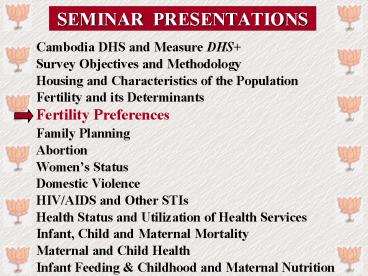SEMINAR PRESENTATIONS - PowerPoint PPT Presentation
1 / 19
Title:
SEMINAR PRESENTATIONS
Description:
Title: PowerPoint Presentation Author: swirl girl Last modified by: Measure/DHS+ Created Date: 8/30/2001 12:32:28 AM Document presentation format – PowerPoint PPT presentation
Number of Views:76
Avg rating:3.0/5.0
Title: SEMINAR PRESENTATIONS
1
SEMINAR PRESENTATIONS
- Cambodia DHS and Measure DHS
- Survey Objectives and Methodology
- Housing and Characteristics of the Population
- Fertility and its Determinants
- Fertility Preferences
- Family Planning
- Abortion
- Womens Status
- Domestic Violence
- HIV/AIDS and Other STIs
- Health Status and Utilization of Health Services
- Infant, Child and Maternal Mortality
- Maternal and Child Health
- Infant Feeding Childhood and Maternal Nutrition
2
(No Transcript)
3
Fertility Preferences
- Desire for more children
- Ideal number and fertility planning
4
Fertility preferences of women
5
Women who do not want more children, by residence
and education
Percent
6
The desire to limit childbearing varies
greatly by region
lt 35 35 to 45 45 and
Kampong Spueu (3) Kampong Thum (13)
Takaev Preah V./Stueng T./Kracheh Siem
Reab/Otdar Mean Chey
CAMBODIA Kampot/Krong K./ K.P.
Sihanouk Phnom Penh Mondol K./Rotanak
K. Kampong Chhnang Prey Veaeng Svay
Rieng Bantey Mean Chey Kampong Cham
Kaoh Kong Kandal Bat Dambang/ Krong Pailin
(53) Pousat (67)
7
Fertility Preferences
- Desire for more children
- Ideal number and fertility planning
8
Ideal number of children
- Women with no children
- How many children would you like to have if you
could choose the number of children to have? - Women with children
- If you could go back to the time when you did
not have children and could choose exactly the
number of children to have, how many children
would you have liked to have?
9
Ideal number of children, for all women
Average number of children
10
The ideal number of children does not vary much
by region
? 3.5 3.6 to 3.8 3.9
and
Phnom Penh (3.1) Svay Rieng Prey
Veaeng Pousat Bat Dambang/ Krong
Pailin Takaev
CAMBODIA Kaoh Kong Mean Chey Kandal
Bantey Mean Chey Siem Reab/Otdar
M. Kampot/Krong K./ K.P. Sihanouk
Kampong Thum
Kampong Chhnang Preah V./Stueng T./Kracheh
Kampong Cham Mondol K./ Rotanak K. Kampong
Spueu (4.3)
11
The ideal number of children has been decreasing
by generation
12
Are women having more children than they would
like?
(4.0)
(3.1)
(4.2)
(Actual TFR)
(4.5)
(4.0)
(2.9)
13
Were pregnancies planned, at the time of the
conception?
14
Fecund women are considered to have an unmet need
for family planning if
. They either wish to space their next birth
or .They want to limit childbearing
BUT are not using family planning!
15
Unmet need by residence and education
Among currently married women
16
Nationwide, 42 percent of the total demand in
family planning is satisfied
17
Main Findings
- 2 women in 5 do not want anymore children.
- The more educated women are the less likely to
limit their childbearing. - The ideal family size is 3.6 children among women
and it is decreasing by generation.
18
- 1 in 3 pregnancies was mistimed or unwanted at
the time of conception. - Unmet need for family planning is 33 and the
percentage of demand satisfied is 42.
19
(No Transcript)































